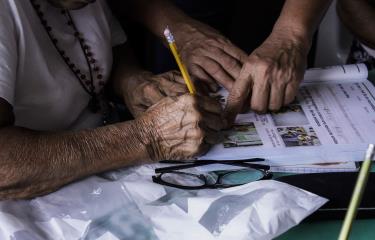Adult literacy cost does not add up in recent years In the Dominican Republic
Adult literacy cost does not add up in recent years In the Dominican ... Dominican Today


Sustainable Development Goals and the Cost of Literacy Programs in the Dominican Republic

Santo Domingo.- According to data from the Directorate of Strategic and Special Projects of the Presidency (Propeep), the cost per literate person in the implementation of the Plan Quisqueya Aprende Contigo has increased over the years. The cost went from 4,393 pesos per literate person in 2015 to 141,873.71 pesos per person in 2022.
Cost Analysis of Literacy Programs
- In the second cycle of the program (2015-2017), operating expenses amounted to 2,437.4 million pesos to teach literacy to 156,004 people, resulting in a unit cost of 15,624 pesos per literate person. This was 3.56 times higher than the cost in the first literacy cycle, with fewer participants.
- In the third cycle of the program (2018-2019), operating expenses totaled 2,211.59 million pesos to educate 118,783 people, resulting in a unit cost of 18,619 pesos per literate person. This was 4.22 times higher than the cost in the first literacy cycle.
- From 2020 to 2022, 21,444 people became literate, and a total of 3,042,340 pesos was spent. The unit price increased significantly to 141,873.71 pesos per literate person, which is 15 times higher compared to the previous cycles.
It is worth noting that no results were reported for 2021. By December 2022, 1,199 literate individuals were reported, including 1,188 coordinated efforts between the General Directorate for Adults of the Ministry of Education, the National Police, the Armed Forces, and civil society entity Dominican ALFALIT. Additionally, 11 individuals were literate through Propeep and the La Famosa Company.
Collaborative Efforts and Learning Centers
- Propeep registered 3,883 illiterate individuals to be literate, and an agreement was signed with the UASD (Autonomous University of Santo Domingo) to include students from the Faculty of Educational Sciences in the National Plan of Dominican Literacy Aprende Contigo. The agreement also involved the establishment of 14,333 learning centers.
Impact and Current Status
The Plan Quisqueya Aprende Contigo has received attention as it initially achieved literacy for 729,517 individuals, reducing the illiteracy rate from 14% to 5.5%. However, the program is currently on hold, and the illiteracy rate has risen to 6.5%.
SDGs, Targets, and Indicators
-
SDG 4: Quality Education
- Target 4.6: By 2030, ensure that all youth and a substantial proportion of adults, both men and women, achieve literacy and numeracy.
- Indicator 4.6.1: Proportion of the population in a given age group achieving at least a fixed level of proficiency in functional (a) literacy and (b) numeracy skills, by sex.
-
SDG 17: Partnerships for the Goals
- Target 17.17: Encourage and promote effective public, public-private, and civil society partnerships, building on the experience and resourcing strategies of partnerships.
- Indicator 17.17.1: Amount of United States dollars committed to public-private partnerships.
Analysis
1. Which SDGs are addressed or connected to the issues highlighted in the article?
The issues highlighted in the article are connected to SDG 4: Quality Education and SDG 17: Partnerships for the Goals.
2. What specific targets under those SDGs can be identified based on the article’s content?
Based on the article’s content, the specific target under SDG 4 is Target 4.6: By 2030, ensure that all youth and a substantial proportion of adults, both men and women, achieve literacy and numeracy. There is no specific target under SDG 17 mentioned in the article.
3. Are there any indicators mentioned or implied in the article that can be used to measure progress towards the identified targets?
The article mentions two indicators that can be used to measure progress towards the identified targets:
– Indicator 4.6.1: Proportion of the population in a given age group achieving at least a fixed level of proficiency in functional literacy and numeracy skills, by sex.
– Indicator 17.17.1: Amount of United States dollars committed to public-private partnerships.
Table: SDGs, Targets, and Indicators
| SDGs | Targets | Indicators |
|---|---|---|
| SDG 4: Quality Education | Target 4.6: By 2030, ensure that all youth and a substantial proportion of adults, both men and women, achieve literacy and numeracy. | Indicator 4.6.1: Proportion of the population in a given age group achieving at least a fixed level of proficiency in functional literacy and numeracy skills, by sex. |
| SDG 17: Partnerships for the Goals | Target 17.17: Encourage and promote effective public, public-private, and civil society partnerships, building on the experience and resourcing strategies of partnerships. | Indicator 17.17.1: Amount of United States dollars committed to public-private partnerships. |
Behold! This splendid article springs forth from the wellspring of knowledge, shaped by a wondrous proprietary AI technology that delved into a vast ocean of data, illuminating the path towards the Sustainable Development Goals. Remember that all rights are reserved by SDG Investors LLC, empowering us to champion progress together.
Source: dominicantoday.com

Join us, as fellow seekers of change, on a transformative journey at https://sdgtalks.ai/welcome, where you can become a member and actively contribute to shaping a brighter future.







